Out of the Box
Once the bike was in my hands, I went over every millimeter of the frame looking for (full confession) any flaws or weird lapses in craftsmanship.
Five days in, I still didn’t really find any. No voids in, or crookedly chased welds, no pinner machined plates that looked likely to crack. Just a really nice looking welded aluminum frame reminiscent of something from Turner or Ventana (that’s a compliment, if dated). It’s not full of sexy hydroformed shapes, but it looks solid and well done.
It’s also just burly looking. There’s almost no rear triangle flex when pushed, and I’ve had DH bikes with less substantial downtube / headtube / top tube junctions.
The dropouts and pivot junctions are thick machined bits, the main pivot is large and rests in angular contact bearings, and that bigass headtube looks ready for some abuse (as well as ready to take some offset headset cups if you want to tweak).
There are lots of photos of the details on the Guerrilla Gravity website, but one I didn’t find is this: the machined hole guides for the rear shock mounts. They work, and make life a little easier when moving the shock around.
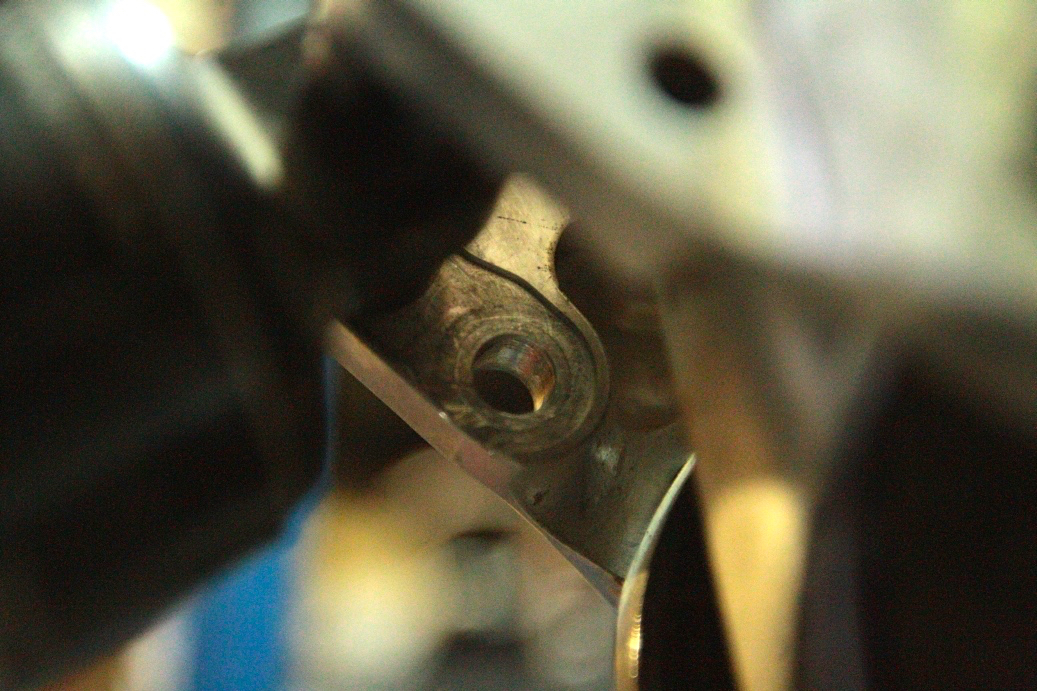
The Ride
Following recommendations from Matt at Guerrilla Gravity on shock tweaks, I took the Megatrail out to an old DH collegiate racecourse in Reno, Nevada.
Since this is a trail bike, I pedaled up on a singletrack that’s mellow and smooth at the beginning, and then a little steeper and a lot chunkier higher up—this while in the 150mm travel trail mode.
Right away I noticed what was to become a theme for the next few days: that Cane Creek Inline shock. It REALLY likes to use its travel, no matter what it’s doing. It’s got a more elaborate set of damping circuits than most air shocks, so there’s lots to fiddle with to tame that behavior. But that air spring is a special breed of loose. It made the bike feel a little Nomad-esque, using most of its travel, most of the time. That isn’t really something I’m a fan of. It’s no biggie on climbs, and actually makes the bike pretty forgiving at 4mph uphill, but it had my attention when it became time to go down.
(And yes I cranked up the low speed rebound and compression damping. That air spring is weird, and the seemingly endless damper settings had me chasing around a few settings that would have better been dealt with on the spring side.)
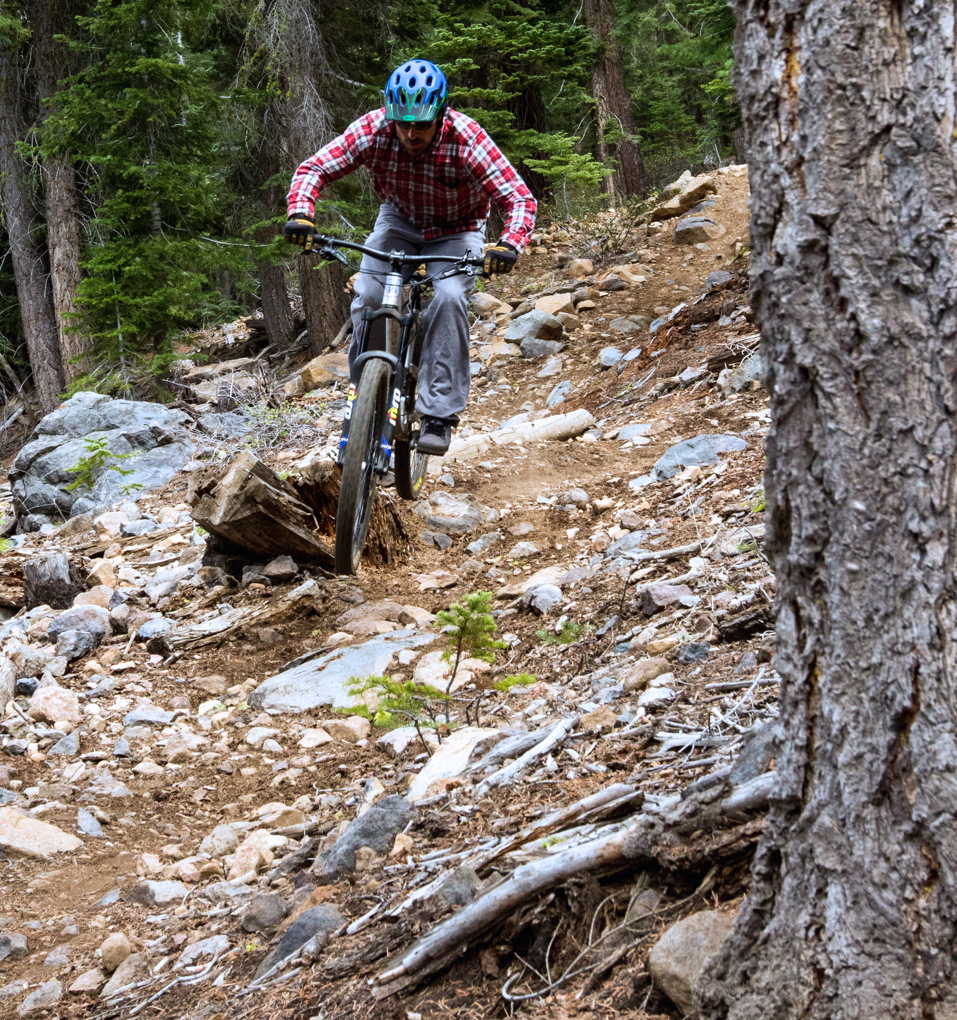
I proceeded to ride the bike 5 days for a few hours each day, with lots of climbing in all four modes, a little more descending in all four modes, and lots and lots of shock tweaking (including throwing in a Rockshox Monarch Debonair into the mix). Here’s a summary:
Travel / Shock Modes
The Megatrail has two shock mount holes on each end for the shock. The rear set dictates travel and geometry, the front two determine shock rate.
This handy graphic shows the progression:
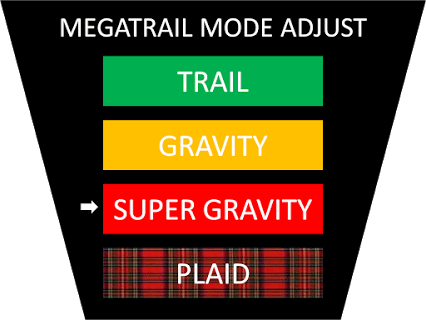
Trail Mode
Guerrilla Gravity describes trail mode as ‘pedal and pop’ which is about as good a description as I could come up with. At a 13.2” BB and a 66.5 degree head angle It pedals well, is balanced both down and up, and felt immediately comfortable in either direction. I really don’t have much to say here, as it responded well to rider input, pumped transitions effectively, and felt instantly familiar popping off smaller lips and boosting over rocks to smoother pastures.
The amount of plow capacity could be easily manipulated with shock settings. Playing with damping and sag alone, there’s a good range in this configuration to either jump over or slam into about anything. And the fact that I have no real gripes here says more positive about the bike than you might realize. It’s just a really well balanced, all around setup.
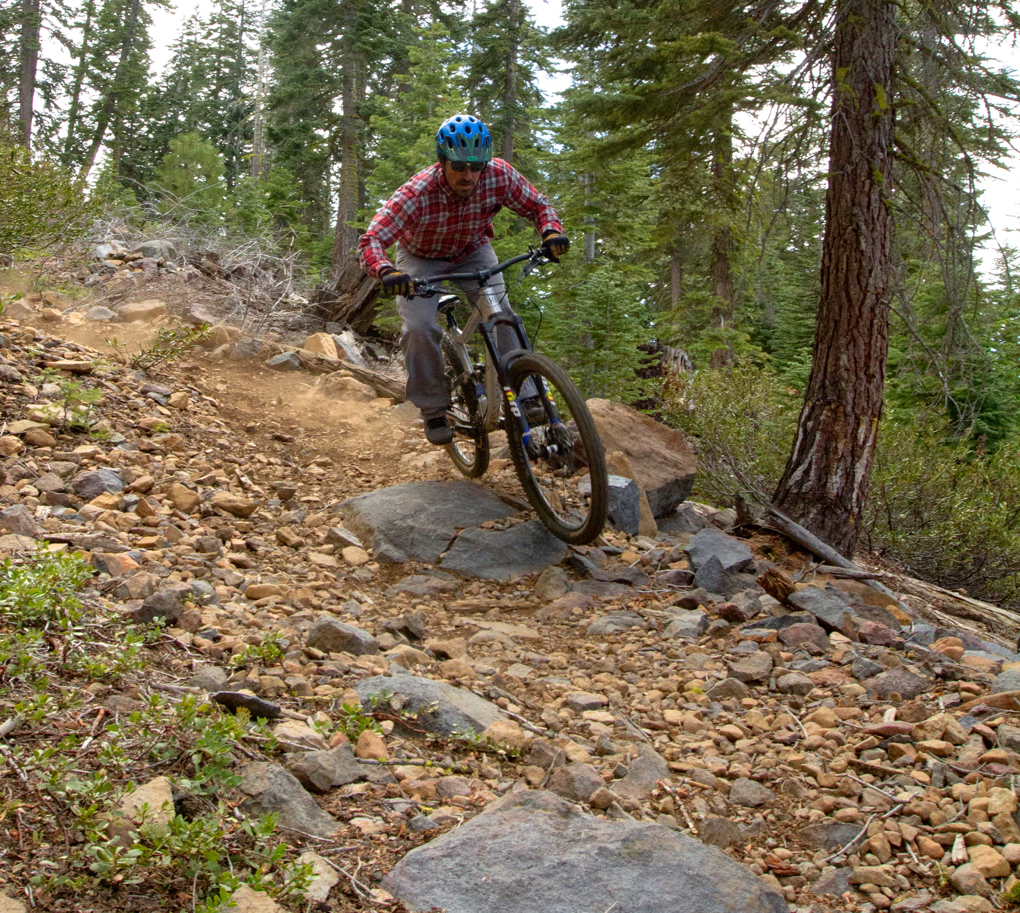
Gravity Mode
Gravity mode is accomplished by moving the rear shock mount to the lower hole, which accomplishes several things: it (1) lowers the bike into the slacker and low BB setting, (2) increases the leverage rate, which provides more wheel travel, and (3) gives the frame a slightly more linear shock rate.
That’s a lot to digest, but rightly so: it definitely transforms the bike into something else entirely.
The biggest change into Gravity mode is the geometry change. At a 12.7” BB height and 65.5deg HA, this frame now absolutely rails. Your center of gravity is lower, exaggerated by the more linear shock rate, and the Megatrail is now ready to just rail corners and run into shit.
It’s so much more stable, it actually becomes kind of fun to ride like a hack. Whether you hit your intended lines or not, you won’t be getting bucked. You might slow down and bang up some wheels, but this is a very stable little 30 lb bike in this mode, more so than any other 160mm trail bike I’ve ridden. And for the other bikes that come close, that’s all they do.
The slack geometry while climbing combined with a more linear shock rate made the Megatrail really move through its travel easily while climbing, although it was greatly improved using the Monarch rear shock. The steep seat tube angle helps immensely here. And the BB height wasn’t nearly as much of an issue as you might think. You’re not likely to hit something you wouldn’t have with an extra half inch of bottom bracket height, you just may hit it a little harder. But the bike is incredibly planted, almost to a fault. Which brings me to…
Super Gravity Mode
Super Gravity Mode is gravity mode using the bottom front shock mount. Same travel and geometry as Gravity Mode, just with a more progressive shock rate.
This became my personal zen setting.
It’s low, it’s slack, and it saves a little travel for when you’re just loading the suspension in corners or on lips, and saves some ‘give’ for when you really knock something hard.
For all the suppleness of Gravity mode, the increased progressive feel in Super Gravity becomes the aftermarket turbo on the backsides of transitions.
If I owned this bike, SG mode is where it would live 80% of the time. It both climbs and descends with a much more solid feel than in Gravity mode without moving through the travel as easily. The more snappy climbing was especially a huge bonus. The other 20%? Next paragraph…
Plaid / Super Trail Mode
The shorter travel / higher rear mount coupled with the lower front hole constitutes a non-advertised fourth meal which is just a more progressive version of Trail Mode.
(Ok, “Plaid Mode” isn’t really an official name, Matt sent that graphic to me as a joke because that shock mount configuration wasn’t something they’d been promoting. It’s not like using it is discouraged or anything, it’s just the three other configurations were what he’d focused on when designing the bike.)
This setting is quick. Like incredibly responsive quick.
In Super Trail Mode, you’ll get a little more negative feedback when you get off line, but the bike still stays composed. The payoff is that the bike becomes really efficient, accelerating quickly, and popping hard when you want to lift it.
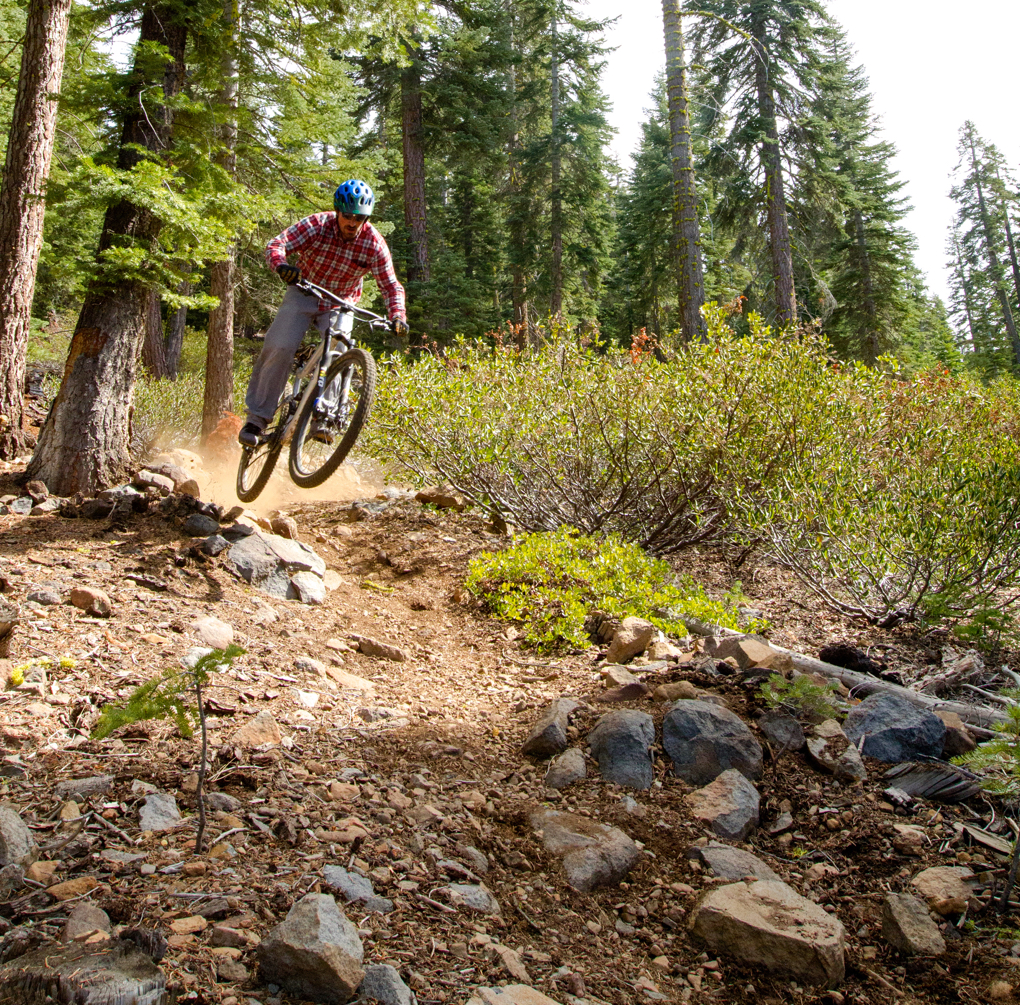
I’d probably call this the Firecracker Mode. It actually makes the bike faster on trails where there’s not a lot of just holding on and trying to keep your vision clear. This is definitely the setting I’d use on all day, longer rides. Guerrilla Gravity should tout Plaid Mode a little harder. My favorite new term is “squirting out of the back of transitions.” Plaid Mode squirts.
An interesting side note is that using the Cane Creek Inline shock in this mode helped that air spring feel like the Monarch in Regular Trail mode. It gets a little confusing with all the options but it’s good to have them.
NEXT: The Frame, Pedaling, Weight, Etc.

This looks like a sweet rig, especially for a compulsive tinkerer like myself. Any comparisons to the Knolly Chilcotin? That’s my current rig and it sounds like it might share some similarities in design and ride characteristics.
Also for the record, I bought a CCDB Inline in September. Yesterday I finally got it feeling perfect. That little sucker takes some real dialing in.
I have ridden a Chilcotin for a day. I thought it descended well but the headangle was a little steep for my tastes, and I wasn’t really impressed with how it pedaled. Whether descending or climbing, it seemed like the rear end was in a pretty constant state of squatting and catching on things. Take that for what it’s worth though, I certainly don’t know the bike as well as an owner would and I only messed around with air pressures and rebound damping on the shock. Coasting descents, I thought it was a pretty solid ride. As far as a comparison, I’d say the angles of the Megatrail in one of the longer travel modes make it something the Chilcotin probably couldn’t compete with.
Good to hear about your tuning adventure on the shock. It seems to be a common theme with most of my friends who have ridden them.
Cool, thanks for the reply. Did you try the Chilli in slack or steep mode? It makes a massive difference IME. No doubt in my mind that the Chilcotin is a very suspension dependent bike. When I first bought it I thought I might have made a mistake, but I’ve since discovered that it was just set up wrong for me.
The Megatrail looks really, really cool though. I love the adjustability of it. The range of personalities you can give it seems huge. Badly want to play with one after reading this review, which is really the first I’ve heard about how it actually performs.
I believe it was in the slacker setting but I wouldn’t bet my life on it.
“even when taking into account a number of tomahawks into rock gardens”
I love this phrase. I have had this bike since October last year and been to Moab three times with it, and I plowed through Porcupine significantly faster than any of my friends, several of who are better riders than me, because of both the geometry of the bike (slack head tube, low BB) and how well built it is. Oh, and I was in trail mode. After reading this review, I wish I had put it in Plaid mode, but I am worried that I would’ve destroyed my rims going at warp speed, given how fast I was already going in trail mode. If you want a bike that can handle abuse (I am 195lbs, 6’1″ and ride sloppy), this is the bike to go with.
Kevin, I loved your review. Very open minded and honest. I test rode one at Bootleg over a month ago and am expecting mine to arrive in about a week. For many of the same ride qualities you expressed, I’m selling my SC 5010c wunder bike.
my question is the shock. I put a monarch plus on my 5010 and it was night and day better than the fox it had. I really like the shock, but the guys at GG advised the cc inline. I still have time to change it, what would you suggest? I’m 150lbs, love the gnar…but usually do a ton of climbing. So I need something that has good mid stroke. Also love to play and “pop” on the bike. Thanks for your feedback, Rod.
Thanks Rod. I would say the easy answer is that the Monarch is the simpler setup of the two. I’ve got a CC inline shock that I just put on my own personal bike (2014 Norco Range Carbon) and to be honest, I’m having to revise my opinions a bit. I’ve only got a few rides on it but I’m not getting the same problems I had on the Megatrail. I’m now wondering if there was something up with the individual shock. Neither bike has a very complex leverage curve so I doubt it’s the difference in frames.
I’ve had good longevity out of the Monarch shocks I’ve had. You won’t have the minute precision in damping adjustments that you do with the inline but it will probably get you riding the bike comfortably a little sooner. The few friends I’ve had with inlines had both difficult setup times, and most of them have had to send theirs back for service within a year.
I don’t really feel comfortable making a choice for you as I honestly think either shock will work well, but hopefully that helps. If you do get the inline, I would definitely try to get some volume spacers with it.
Solid review, I’m going to try the “plaid” shock setup next ride. I really like my small Megatrail, Guerrilla Gravity is a great company and has excellent customer service. Will worked closely with me to get the best parts spec for my budget, we went through the parts +$ or -$ and pros and cons. Plus they are equally responsive to questions after I took delivery. Fantastic to get a bike with exactly what you want!
A note on sizing, I am 5’8″ and rode the medium and small. The medium was a bit more comfortable going uphill but the small was better for me going down. I have a short inseam at 30″ and the stand over on the medium seemed a touch high. That said, the small is awesome with a 40mm stem and 760mm bars.
Hey Kevin, what trail is this? I just moved to reno about two years ago and I’m still scouting trails. Thanks.
Thanks for the feedback Kevin. I think I’m going to give the CC Inline a try and see how it goes. The guys at GG have been great to work with so far and I’m sure they’ll stand by their product…so If I can’t get it sorted out in the first month or so, I may get a hold of them to see if I can swap it out for the Monarch Plus.
The MRP fork seems to be getting some good press. One thing that’s especially appealing is their advertised axle-to-crown, which is 10 mm lower than a 27.5 Pike of Fox 34 in the same travel. This means you could potentially run the MRP Stage with 10 mm extra travel without affecting geometry.
That said, I don’t fully trust that different brands measure things such as axle-to-crown the same way. Has anyone measured the Stage in comparison to, say, a Pike?
Multiple leverage rates and geometries are great and all, but I wonder if Guerrilla Gravity could shave a little weight off the frame by eliminating the adjustable geometry. ??
Probably like 7 grams.
Holes surrounded by aluminum don’t tend to weigh that much.
So they’re using holes, then. Dialed.
Great review. I now have narrowed it down to two frames, MT and the Norco Range Carbon, which you mention is your personal bike. I have had a short test ride on the Range and liked it. How does the MT compare to the Range?